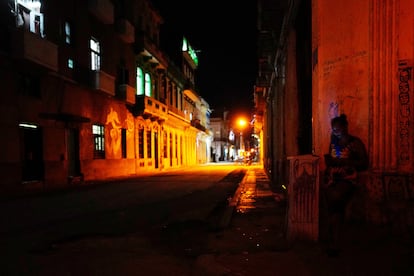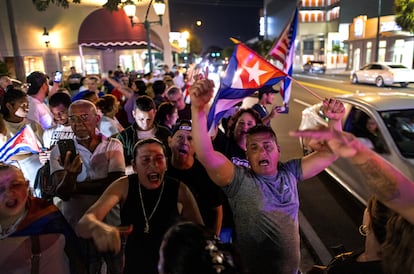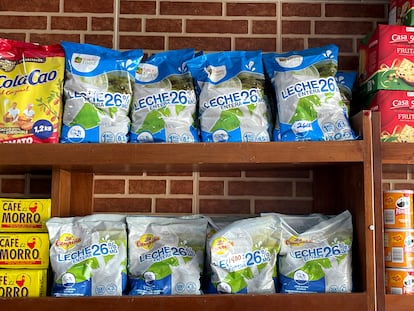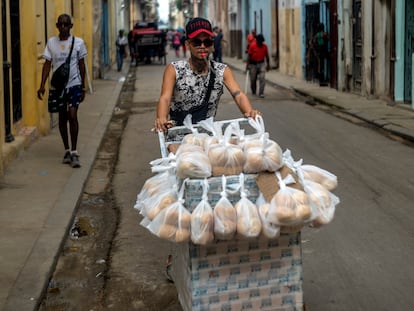Cuban government delivers rice and milk to quell protests, but discontent continues
There is so far no confirmation of how many people were arrested at Sunday’s protests, where crowds of Cubans came out to the streets to demand ‘freedom,’ ‘electricity’ and ‘food’

Sunday in the city of Santiago de Cuba started off “quietly.” That’s according to residents of the Cuban city who spoke to EL PAÍS after the Cuban government tried to quell the mass protest that began on Avenida Carretera del Morro in Santiago de Cuba, and spread to several provinces. Cubans took to the streets on Sunday to protest against electricity and food shortages. In response to the demonstration, the government sent trucks loaded with food to a warehouse in the city of Santiago de Cuba, Beatriz Johnson Urrutia, the Communist Party’s first secretary in the same-named province, said that the government would immediately deliver rice and sugar to the population.
“Those supposed trucks that arrived do not mean that they are going to start selling rice, sugar or milk to the population. They are only now distributing this month’s rice and sugar that had not arrived. They have not delivered milk for children,” says a resident of Santiago de Cuba who asked to remain anonymous. According to this witness, the situation is otherwise calm. “Everything is quiet here, as usual. They knocked out the power last night and, with the streets in darkness, there was no choice but to go back home.” The resident adds that several police patrols and State Security agents were guarding the city on Monday.
Although the protests seem to have subsided in Santiago de Cuba, there were signs of unrest on Monday in the town of El Cobre, which is also in Santiago de Cuba province. In videos posted on social media, residents are seen chanting “freedom” outside the police headquarters and demanding the release of the people arrested on Sunday. A source told EL PAÍS that the towns of La Coloma and El Cayuco also took to the streets on Monday. Due to constant cell phone service outages and difficulty accessing the internet, it is impossible to verify or record events from the island.
Military deployment and arrests
Street protests were recorded in several municipalities in Cuba until the early hours of March 18. In Bayamo — one of Cuba’s most historically significant cities, where the national anthem was born — Cubans took to the streets singing the anthem, and the government responded with repression. Several videos recorded in the city — which residents burned down in 1860 to fight the Spanish occupation — showed police officers beating citizens fleeing arrest. In the footage, soldiers from the Special Forces (Black Wasps) are also seen trying to quell the demonstrations.
Close to midnight on Sunday, citizens in the town of Cárdenas, in the west of the island, joined the protests, banging pots and pans in the middle of a blackout that lasted several hours. Young people and mothers carrying children walked through the Santa Marta neighborhood in Cárdenas. Others took to the streets of the cities of Alquízar and San Antonio de los Baños. Outside the country, Cuban exiles also demonstrated, from the legendary Versailles restaurant in Miami to the headquarters of the Cuban embassy in Montevideo, Uruguay.

Sunday’s demonstrations brought to mind the historic protests that took place across Cuba on July 11 and 12 of 2021. Thousands of people came out to protest in what was the largest demonstration since the triumph of the Cuban Revolution.
On Sunday, the Cuban government used police repression to contain the protests — just as it did in 2021. Organizations that independently record detainee numbers in Cuba found it difficult to document all the arrests. Cubalex and Justicia 11J were able to confirm the identity of at least four people who were “violently” detained. The whereabouts of some of these detainees is still unknown.
On Sunday, Cuban President Miguel Díaz-Canel issued a thread of messages on his X account in which he acknowledged citizen discontent “with the situation of the electricity service and food distribution.” In view of the situation, the president said authorities wanted “to attend to the demands of our people.” But on Monday, Díaz-Canel blamed “mediocre politicians and terrorists” in South Florida for “stirring up the streets of Cuba.” The president said that authorities had effectively shut down the demonstrations, claiming that the people were “left wanting more.”
Vice Foreign Minister Carlos Fernández de Cossío also said the protests were a “desperate attempt by the United States to destabilize Cuba.” Foreign Minister Bruno Rodríguez made the same argument, adding that, if the United States “was concerned about the well-being of the Cuban people” it would lift the economic “blockade” and “remove Cuba from the list of alleged state sponsors of terrorism.”
The protest on Sunday may have ended with calls for “freedom,” but the demonstration began with demands for “food” and “electricity.” Even the Cuban government has acknowledged the economic crisis in the country, comparable only to the so-called “Special Period” in the 1990s. Today, Cubans are suffering from hours-long power outages and shortages of food and medicine. And the situation only seems to be getting worse.
Sign up for our weekly newsletter to get more English-language news coverage from EL PAÍS USA Edition
Tu suscripción se está usando en otro dispositivo
¿Quieres añadir otro usuario a tu suscripción?
Si continúas leyendo en este dispositivo, no se podrá leer en el otro.
FlechaTu suscripción se está usando en otro dispositivo y solo puedes acceder a EL PAÍS desde un dispositivo a la vez.
Si quieres compartir tu cuenta, cambia tu suscripción a la modalidad Premium, así podrás añadir otro usuario. Cada uno accederá con su propia cuenta de email, lo que os permitirá personalizar vuestra experiencia en EL PAÍS.
¿Tienes una suscripción de empresa? Accede aquí para contratar más cuentas.
En el caso de no saber quién está usando tu cuenta, te recomendamos cambiar tu contraseña aquí.
Si decides continuar compartiendo tu cuenta, este mensaje se mostrará en tu dispositivo y en el de la otra persona que está usando tu cuenta de forma indefinida, afectando a tu experiencia de lectura. Puedes consultar aquí los términos y condiciones de la suscripción digital.
More information
Archived In
Últimas noticias
Maduro pleads not guilty before the federal court in New York: ‘I am still the president of Venezuela’
A new test can detect Alzheimer’s from a finger prick
UN team enters Sudanese city of El Fasher after paramilitary massacre: ‘It’s like a ghost town’
A recipe for resistance: Indigenous peoples politicize their struggles from the kitchen
Most viewed
- Gilles Lipovetsky: ‘If you want to live better and fall in love, take Prozac, don’t look to philosophy’
- Alain Aspect, Nobel laureate in physics: ‘Einstein was so smart that he would have had to recognize quantum entanglement’
- Alvin Hellerstein, a 92-year-old judge appointed by Bill Clinton, to preside over Maduro’s trial in New York
- Why oil has been at the center of Venezuela-US conflicts for decades
- Maduro’s downfall puts China’s relationship with Venezuela to the test











































